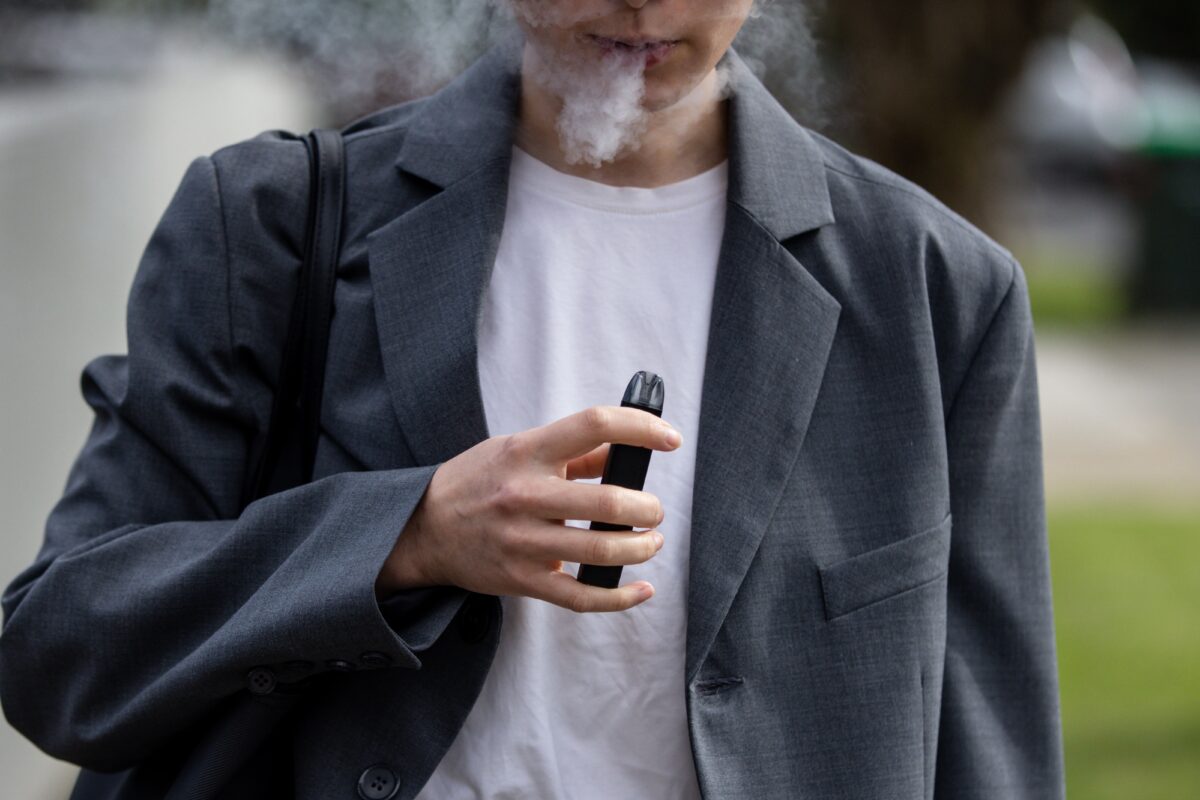


A recent study from the U.S. Centers for Disease Control and Prevention (CDC) has revealed that more than one in ten American young adults were using vapes, a concern given the negative impact e-cigarette usage can have on young brains.
The July 21 CDC study (pdf) found that 11 percent of young adults aged 18-24 were current e-cigarette users. Vaping among this demographic is a concern “because nicotine adversely impacts brain development, which continues into the early to mid-20s.” Young adults were the most likely to use e-cigarettes among all adults.
Young adults were also found to be more likely to be dual users of e-cigarettes and cigarettes when compared to adults aged 45 and above.
“Dual use of tobacco products is a health concern because it may result in greater exposure to toxins and worse respiratory outcomes than using either product alone,” the study stated.
“E-cigarette use among adults aged 18 and over generally declined with increasing family income.” Vaping was popular most among White adults living in low-income households.
According to the CDC, most vapes contain nicotine. Vapes that do not disclose whether they contain nicotine have been found to have the substance. This is even true for vape liquids that are being marketed as zero percent nicotine.
During adolescence, nicotine use can end up harming the regions of the brain that control learning, impulse control, mood, and attention. Typically, stronger connections are built between brain cells when a new memory is created or a new skill is learned.
Among young people, these connections form faster. However, nicotine alters the way connections are made.
According to a blog post at the University of Nevada, Reno, those who vape are more likely to experience cognitive function interference, popularly known as “brain fog,” compared to their peers who do not vape. This can lead to greater difficulty in concentration and decision-making as well as a harder time remembering things.
Many vaping devices can produce vapor containing the element lead, which can damage the brain. Vaping can also harm the lungs, mouth, heart, and gums.
According to the July 21 CDC study (pdf), 4.5 percent of adults above the age of 18 were current vapers.
“Current e-cigarette use varied by race and Hispanic origin; among all adults aged 18 and over, the percentage of White non-Hispanic adults (5.2 percent) was higher than Asian non-Hispanic (2.9 percent), Black or African American non-Hispanic (2.4 percent), and Hispanic or Latino (3.3 percent) adults.”
Vaping is growing among teens and children too. An October 2022 study from the CDC found that 2.55 million middle and high school students reported e-cigarette use last year. More than one in four used them daily.
The growing vaping trend among youngsters has triggered alarm bells given the potential negative impact it can have on their development.
“This study shows that our nation’s youth continue to be enticed and hooked by an expanding variety of e-cigarette brands delivering flavored nicotine,” said Deirdre Lawrence Kittner, Ph.D., M.P.H., director of CDC’s Office on Smoking and Health.
“Our work is far from over. It’s critical that we work together to prevent youth from starting to use any tobacco product—including e-cigarettes—and help all youth who do use them, to quit.”
The e-cigarette industry came into prominence on the premise that vaping is a safer alternative to smoking regular cigarettes, a claim that has never been proven. In fact, a study published in February reported the opposite—that vaping can end up causing more damage than smoking actual cigarettes.
The researchers found that vapers had 2.6 times more DNA damage compared to nonusers, while smokers had 2.2 times the DNA damage compared to nonusers. DNA damage to the oral epithelial cells lining the mouth is a change that is associated with a higher risk for several chronic diseases, including cancer.
Ahmad Besaratinia, the study’s senior author and a professor at the Keck School of Medicine of University of Southern California, pointed out that “the devices and flavors that are most popular and highly consumed by youth vapers, as well as adults, are the ones that are associated with the most DNA damage.”
Some vape manufacturing firms are being made accountable for proliferating e-cigarette use among minors. In March, vaping company JUUL Labs agreed to pay Chicago $23.8 million to settle a lawsuit alleging that the firm had marketed its products to underage users.
“JUUL appealed to youth with their colorful, playful media and social media marketing and used high nicotine contents to fuel ongoing use,” a city press release said.
“E-cigarette businesses cannot be allowed to come in our city and boost their profits at the expense of minors. The use of any tobacco products, including e-cigarettes, among youth is a serious public health concern—to CDPH and parents across Chicago,” said CDPH Commissioner Allison Arwady.
Last year, the company settled thousands of lawsuits brought by families of JUUL users, city governments, school districts, and Native American tribes.


